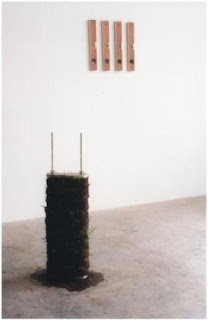

Vista Tracking was a joint show by Sydney-based Sam Smith and Christchurch-based Clare Noonan that discussed the journeying nature of searching for new personal ways to interact with surroundings. The exhibition placed an emphasis on the search for utopias rather than the arrival. San Smith presented a fantastical landscape in which characters search indeterminately but are locked in conflict inside a narrative video loop that never really resolves anything. His audio-visual installation Set Piece engages the relationship of the viewer to the gallery space versus the screen space of video art, undermining any credibility in the characters’search for a personal utopia or newer state of existence. Clare Noonan's work reinvents the way we measure and perceive the world and its surroundings by presenting a set of personal and portable measuring devices. These endeavour to evaluate how we individually account for the journey and search towards an understanding our own privatised space. Drawing upon memory, significant places are referenced through man-made devices in conjunction with organic artefacts, such as natural samples and earth cores, from these locations.
For more info see, the HSP catalogue, Pastoral Propreity by Harold Grieves or Sally McIntyre's article in The John Dory Report (Spring, 2004).
From Pastoral Propreity
If there is such a thing as decency, then Clare Noonan’s treatment of HSP’s front room might be riding in line for an award. For her’s is such a profesionalised finish, replete with sculptural room, and the kind of audience contemplation detail Public galleries so dearly love (but never seem to achieve) that it’s hard to get past just how great the show looks and start to recognise how the work so carefully manipulates our feelings. Anyone remembering last years show is going to recognise a lot of the same placement issues, or at least the same arc from entranceway to the veiled curtains of the darkened projection room (the measuring device, seems to be in the same place Oil Column (Liquid North) was in last year). Which is not at all a bad thing and shows that Noonan knows how to work a room, but then, when her work is so much about placement and orientation, why wouldn’t she? Placement seems to lie at the heart of Noonan’s practice, and with Vista Tracking she seems to be going in for the whole pastoral Kiwi-land thing. Hence all those vast empty spaces of the tele-visual brochurism of the psuedo-Graham Sydney background musak complet with indolent vineyard back-country NZ-Aotearoa celebration vibe are gently oscillating in the background of what is upon first appearances a nostalgic, attention grabbing, amateur-geology-gone-art-practice that wants so earnestly to un-hinge our dependably static predictability in an attempt to really understand something about ‘the place we stand in”. Which isn’t really a bad thing, but is so sorely that bad reading reality of state sanctioned art, the kind of reading a Public gallery charter pins to the wall in a self-congratulatory manner which is the very thing HSP should be trying to avoid. - harold grieves 2004.
From The John Dory Report .
Noonan’s careful, elegant forms, which reference the apparatus and methods of various crafts and sciences, geology, leatherwork, woodwork, create, instead, an art of the landscape which is unable to rest on the contemplative visual surface and instead finds more interest in practicality and intervention, the excavation and display of the view. Its ‘vistas’ then, are shorn of their required distance and are broken down into particles, core samples, and fragments of actual turf, by means of scrutinising and measuring devices which become prosthetics for more imprecise, poetic human responses in which the eye, the hand, the foot, stand ‘corrected’. This is about looking, not from lofty mountaintops, but on a more precise, specific, and ‘down to earth’ level. Noonan’s landscapes are mined for their essence in a manner that seems to pastiche scientific and museological tendencies to reduce, compartmentalise and categorise while remaining respectful of the answers facilitated through such intently practical means. The sculptor is recast as a toolmaker in her conceptual toolshed where items hover on the borderline between art object and functional device. There is a kind of blank humour at work here, for instance the 6 ft deep hole, dug in the greenness of a rural Canterbury paddock, which just so happens to also be the artist’s backyard, could easily be read as a parody of the Romantic ‘deep interior’ and that long running search for ‘depth’ (all vistas are, in one sense, Romantic). This dig runs a narrative thread through Noonan’s installation and is represented both photographically and in the numerous discrete pieces which take dirt, stones and grass from the contents of the hole and the surrounding area. Specific sculptural forms are, quite literally, filled with Noonan’s home ground, their containing structures functioning as display units, although their contents are never quite reduced to mere ‘specimens’. This is particularly the case in one work which layers a tower of footprints cut out of a still-sprouting lawn turf, like a walk in the garden, only stacked and compacted. Here the viewer is presented with a site-specificity that undercuts ‘representations’ of nature, with small skin-grafts of its colour and fecundity instead inscribing the actual organic material of landscape into the whiteness of the gallery space. - Sally Ann McIntyre





